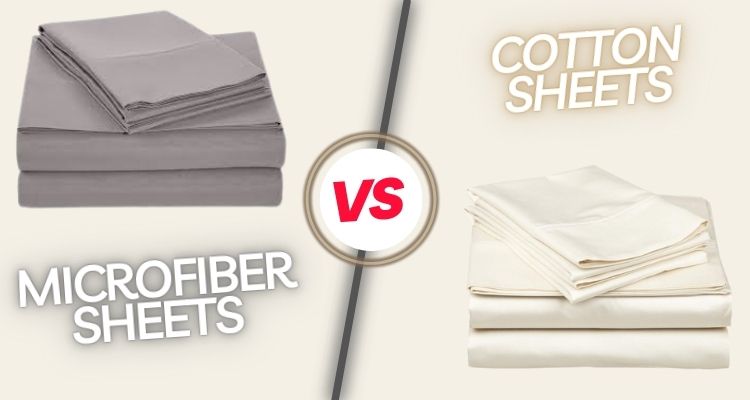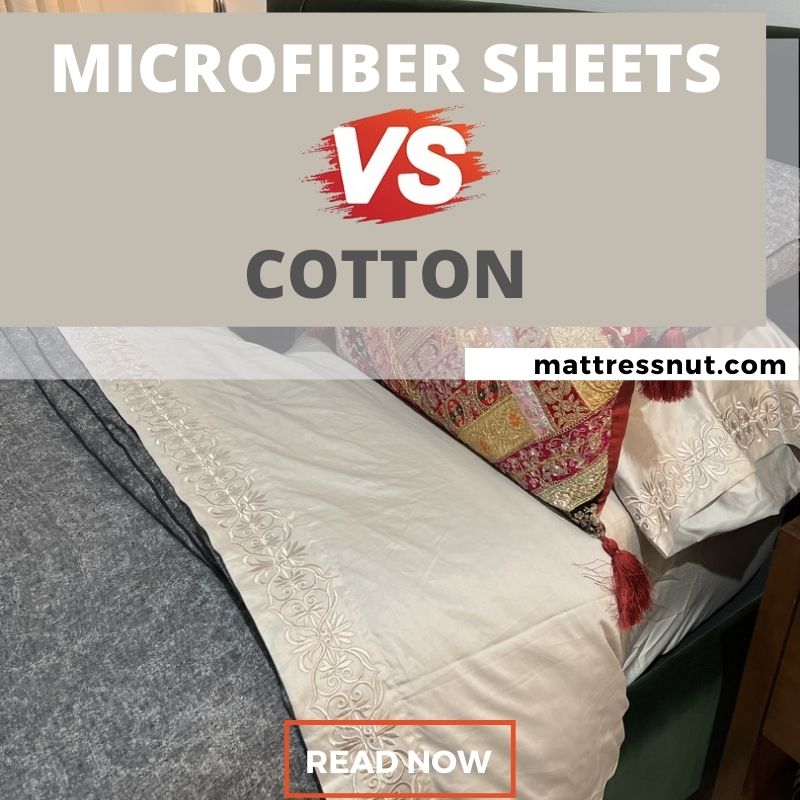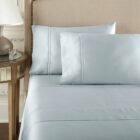Good bed linens are vital for having a good night’s sleep. Bed sheets impact your comfort and prevent them from staining, wear, and dampness. If you’ve invested money in a decent mattress, get some excellent linens to keep it clean.
Cotton and microfibre are two common kinds of bed linens. Cotton is a natural material obtained from cotton plants, whereas microfiber comprises synthetic fabrics like polyester or nylon. So, which is better, cotton or microfiber sheets? We compare to cotton and microfiber sheets to help you decide which is best.
Microfiber Sheets Vs. Cotton Which One Is Better? Our pick
The Yalda Sheet Set’s timeless elegance adds refinement and flair to any bedroom.
The Pure Parima Yalda Sheets tick several boxes for those looking for high-quality Egyptian cotton bedding. These sheets are soft right out of the bag, even though Pure Pima doesn’t use chemical softeners. These comprise Egyptian cotton and come with Egyptian Cotton Association accreditation. Egyptian cotton helps to regulate body temperature by absorbing excess moisture. This organic material is also suitable for those with sensitive skin.
The sheets have a 400-thread count and are soft, smooth, and silky, providing just the proper amount of comfort. They’re double-hem stitched, so they’ll be solid and resistant even if you toss and turn while sleeping. These sheets can last for many years if properly cared for and stored.
The Yalda sheet set is available in single to Cal king sizes and suits mattresses that are 18 inches thick. The Saatva Classic innerspring hybrid mattress offers high-end support and comfort at a fraction of the cost. Soft pillow-top cushions the body, and an extra layer of coils provide substantial spinal assistance with bounce.
The set’s components are all machine washable. Rinse with a light detergent in warm or cold water, then line dry or spin dry on low heat. Pure Parima suggests cleaning the set separately and without softening agents or bleach.
The Yalda Sheets are affordable compared to similar Egyptian cotton sheet sets, and U.S. delivery is free. Pure Parima provides a 100-night risk-free trial period for testing their bedding. Within 100 nights after the delivery date, returns are acceptable.
Cotton Vs. Microfiber Sheets: What’s the Difference?
Cotton and microfibre are two standard bed sheet fabrics. Here are a few important distinctions between the two:

- Material: Cotton is an organic fabric from the cotton plant, whereas microfiber is a polyester-polyamide combination.
- Softness: Cotton sheets, mainly Egyptian cotton, are smoother and airier than microfiber sheets. Some individuals, however, enjoy the silky smooth texture of microfiber.
- Durability: Cotton sheets are well-known for their longevity and capacity to resist repeated washings, but microfiber sheets may pill or degrade with time.
- Moisture absorption: Cotton is terrific for night sweaters because it absorbs moisture. Microfiber, on the contrary, is less absorbing and can leave you feeling damp or clammy.
- Care and maintenance: Cotton sheets are simple to care for. They are easily washable and dry at home. Microfiber sheets are also simple to care for; however, they may need a lower dryer heat setting to avoid damage.
What are Cotton Sheets?
Cotton linens are fine sheets of organic fiber that are soft and comfortable. This sheet comprises breathable fabrics ideal for allergy sufferers. This is practical since fabric-making often lacks toxic chemicals like bleach and insecticides. High-quality cotton sheets may help night sweaters due to their moisture-wicking and heat-dissipation qualities.
Types of Cotton Bed Sheets
The following is a selection of several kinds of cotton sheets for beds.
Egyptian Cotton Sheets
Egyptian cotton has a highly long staple, resulting in high-quality cotton bedding. This level of quality will cost you a little extra. However, these sheets are very long-lasting, sumptuous, and silky.
The American Upland
If the label specifies 100% cotton, it is probably American Upland cotton. Although this is the most popular cotton sheet, it is constructed with a short thread. They will remain durable but will not be as supple as Egyptian cotton.
Long Staple Cotton Sheets
Long Staple Micro-Cotton is another kind of long staple cotton produced in India. It’s high-quality, long-lasting, and soft like the other long-strand cotton sheets.
Supima Cotton Sheets
American Pima cotton is another name for Supima cotton. It has a long staple and resembles Egyptian cotton. It’s high-quality cotton that’s long-lasting and soft, yet it’s generally less costly than Egyptian cotton.
Pros and Cons of Cotton Sheets
Cotton sheets offer several advantages; no one can think of any disadvantages. However, what if there are disadvantages? Let’s look at the benefits and drawbacks of using a cotton bedsheet!
Pros
- Readily accessible on the market.
- Constructed of natural fabric.
- Accessible at reasonable pricing.
- Needs a little care.
- Long-lasting.
- Anti-allergic.
- Airy and has moisture-wicking capabilities.
Cons
- Susceptible to creases.
- May shrink after washing.
- Costs more than polyester bedding.
- Poor-quality cotton linens may quickly deteriorate over time.
What are Microfiber Sheets?
Microfiber sheets consist of nylon polyester, pulp from wood, and polyester. The sheets are made tougher and softer by using thicker threads in the weaving process. As a result, these sheets are far more durable than cotton and do not wrinkle or shrink after washing. In addition, they are wonderfully soft, silky to the touch, lightweight, and breathable. Microfiber sheets are also stain-resistant, ideal for families with kids and pets.
Pros and Cons of Microfiber Sheets
Microfiber sheets offer several advantages, including the fact that they are inexpensive and soft. However, much like cotton, they have certain drawbacks. Let’s examine the benefits and downsides of microfiber sheets:
Pros
- Wrinkle-free and gentle on the skin.
- Anti-allergic characteristics prevent skin irritation.
- Naturally soft and lightweight.
Cons
- More prone to produce instability.
- The thread count determines its durability.
- Highly absorbent and hence susceptible to stains.
How to Choose Between Cotton and Microfiber?
There are various aspects to consider when deciding between cotton and microfiber. Here are a few things to remember:
Feel and Comfort
Cotton is a standard fabric for bedding. This is partly due to the wide variety of cotton sheets available, each with its feel and comfort. High-thread-count cotton sheets are more luxurious and comfortable. Low thread count choices, on the other hand, may feel scratchy and harsh.
On the contrary, microfiber sheets tend to be relatively uniform. As a result, they feel like silk sheets due to their ultra-thin strands. This silky texture, however, comes with silk’s biggest flaw: a lack of breathing comfort.
Durability
In general, microfiber outlasts cotton. It is likely to hold up long after many washings and is more resilient to wear and tear. Cotton, on the other hand, has the potential to shrink or become deformed after washing.
Maintenance
It is effortless to care for your microfiber and cotton bedding. You don’t have to bother about cleaning them in a particular manner. Therefore, using a washer and dryer on these items is okay. In addition, they are durable and will endure for many years. The only aspect to remember is that microfiber may take longer to remove stains than cotton.
Environmental Impact
Natural fibers like cotton have a lower environmental effect than synthetic fibers since they need fewer chemicals to produce. Therefore in the microfiber vs. cotton debate, cotton sheets are more environmentally friendly.
Our Recommendation
The most excellent sheets for you rely on your sleeping environment and preferences. Before buying, pick according to your needs and analyze the advantages and downsides. You might get a pleasant night’s sleep with either cotton or microfiber bedding.
Both microfiber and cotton bedding are simple to clean. In contrast, its pricing and durability may assist you in choosing which will provide you with the best sleep.


